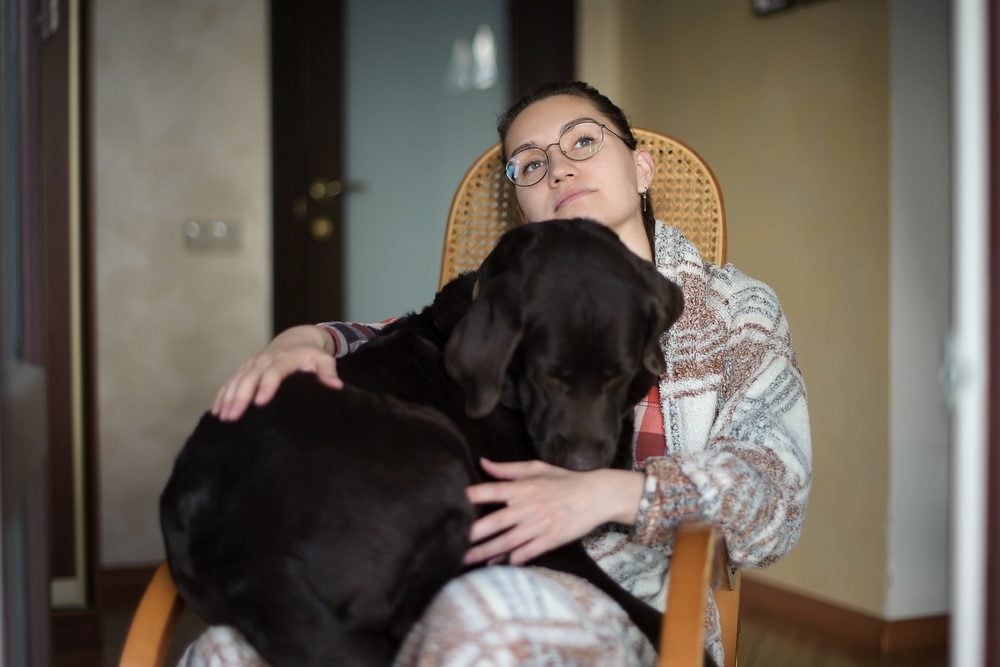Though society has long swept mental health under the rug, awareness of its importance is rising.
Mental health is just as important as physical health, and anyone who has experienced poor mental health will know it is deeply tied to one’s physical health as well.
Even stress, an emotion everyone experiences regardless of whether or not they have a diagnosed mental health disorder, can seriously affect someone’s physical health. Too much stress can cause conditions to worsen and disrupt natural processes like digestion.
While there are a number of ways people can deal with their mental health struggles, those with more extreme symptoms may consider getting a service dog. Psychiatric service dogs can be trained to do several tasks that help with mental health, including deep pressure therapy (DPT).
Many people find deep pressure therapy to be especially effective, which is why having a dog that can perform it without even being told to can make a world of difference.
This article will discuss deep pressure therapy, why it works, who might benefit from it, and what DPT dogs or psychiatric service dogs (PSDs) can do for you.
What Is Deep Pressure Therapy?
Deep pressure therapy is not just something DPT dogs can do; it is a technique that was developed as early as the 60s. It has been used for decades, and there are different ways it can be applied. Additionally, deep pressure therapy is straightforward; anyone can learn how to use and apply it.
Often referred to as deep pressure stimulation, this therapy is used to help calm individuals who are overwhelmed by psychiatric symptoms such as fear, stress, or anxiety. The technique uses firm but gentle pressure application to ease symptoms and help people feel more relaxed.
Some examples of deep pressure therapy include hugging and cuddling, holding, squeezing, swaddling, or stroking. If you’ve ever used a weighted blanket, then you’ve applied deep pressure therapy to yourself.
Why Does Deep Pressure Therapy Work?



If you’ve ever felt overwhelmed by a mental disorder, then you may have felt like it was impossible to control the spiraling thoughts and negative emotions coursing through your brain. During these times, it can be hard even to use tried and true techniques like deep breathing or meditation to regain control over yourself. Sometimes, it feels like nothing works.
So why would something as simple as hugging be helpful? It may sound crazy, but there is a scientific answer to why deep pressure therapy is effective for some people.
Below are the top three reasons why deep pressure therapy can help.
1) It Sends Calming Signals to the Autonomic Nervous System
Using anxiety as an example, when someone experiences a panic attack, their body is in fight or flight mode. The fight or flight response is regulated by a network of nerves running from the brain down through the spinal cord and out to the organs—this network is called the sympathetic nervous system.
When we are hugged or otherwise receive deep pressure, receptors in our bodies send signals telling the brain and body we are safe. This activates the parasympathetic nervous system, which functions to relax our bodies after periods of stress or perceived danger. Both the sympathetic nervous system and parasympathetic nervous system are part of the autonomic nervous system
The parasympathetic nervous system is even responsible for lowering our heart rates and reducing the amount of effort the lungs need to put into breathing when we are at rest. So, deep pressure therapy can send safety signals to our brains, activate our parasympathetic nervous systems, and ultimately help us relax.
2) It Provides Proprioceptive Input
The human body has something called the proprioceptive sensory system. This system is responsible for our sense of bodily awareness. Through the proprioceptive sensory system, our brain receives input from the muscles and joints in our body and can plan and coordinate movement.
It is not uncommon for people with autism spectrum disorder (ASD) to have sensory processing issues. When this happens, they don’t always have the bodily awareness typically provided by the proprioceptive sensory system.
However, deep pressure therapy can help with this. This is because the pressure applied can provide proprioceptive input and help the brain gain a greater sense of bodily awareness. As a result, the brain gets a better idea of where the body is in relation to the space around it, which can help individuals feel more grounded.
3) It Produces Dopamine and Serotonin
When we experience deep pressure therapy, our bodies produce dopamine and serotonin. Dopamine is nicknamed the “feel-good” hormone because when it is released in the brain, it does exactly that: it makes us feel good.
Serotonin does a lot of things, but we’re going to focus on the positive effects it can have when it is produced by deep pressure therapy. Serotonin is believed to regulate one’s mood. When it is at ideal levels, it is much like dopamine, making you feel good.
When serotonin is low, you’re more likely to suffer from anxiety, depression, or other mood disorders. Since deep pressure therapy can stimulate serotonin production, it can help combat stress and help us feel better.
Who Can Benefit From DPT?
Though we’ve been using anxiety disorder as our main example to explain how deep pressure therapy works and how it can help people, it is far from the only mental health disability that can be alleviated through deep pressure therapy.
Below is a list of disorders and disabilities that may benefit from deep pressure stimulation.
- Anxiety disorder
- Autism spectrum disorder (ASD)
- Depression
- Dissociative disorders
- Insomnia
- Post-traumatic stress disorder (PTSD)
- Sensory processing disorder (SPD)
- Attention deficit hyperactivity disorder (ADHD)
- Tourette’s syndrome
- Restless leg syndrome
Though deep pressure therapy can benefit anyone who suffers from any of the disorders on this list, it is considered especially useful for calming children with ASD.
What Is a DPT Dog?



Now that you understand more about deep pressure therapy let’s talk about DPT dogs and what they can do. A DPT dog is typically a service dog that is trained to apply deep pressure therapy to their handler. Psychiatric service dogs, in specific, are commonly trained to perform deep pressure therapy techniques.
They can do this on cue or be trained to respond to certain behaviors, such as trembling, rapid breathing, or other symptoms that may manifest when one is distressed. All sizes of dogs can apply deep pressure stimulation, and there are different ways in which they can do it.
Dogs may be trained to lay on their handler’s torso with their muzzles resting against the shoulder or neck. Deep pressure therapy can also be applied to the legs, with large dogs resting their torsos on their handler’s legs and small or medium-sized dogs laying fully in the lap.
Another DPT skill involves the dog simply laying their head down on the handler’s body. They can rest it on the lap or wherever the handler asks them to.
Though medium and large breeds offer a heftier weight and thus a deeper amount of pressure, small dogs are not without advantages. Small breeds can be taught to ride in slings that attach to their handlers’ bodies; this way, deep pressure therapy can be applied while the handler is upright or walking around.
What Else Can Psychiatric Service Dogs Do?
As we mentioned, most DPT dogs fall under the category of psychiatric service dogs. Psychiatric service dogs are used by people who have mental health disabilities. These service dogs can do much more than just apply deep pressure therapy. Let’s talk about some of the tasks a psychiatric service dog might be trained to do.
Body Blocking
Through body blocking, psychiatric service dogs can help their handlers by creating extra personal space. They can be taught to stand behind, in front of, or on the side of their handler.
If someone is a little too close, the handler can cue their dog to step between themselves and the other person, effectively making space. Dogs can also be taught to circle around their owners.
Another type of body blocking service dogs can perform is intended to block out the world and provide a sense of security. For example, imagine someone is experiencing distress, so they sit down and place their head between their knees as they focus on deep breathing.
The service dog will then sit in front of them, providing them with a little extra privacy and helping them to feel more protected and safe while in such a vulnerable state. For those that feel embarrassed to have such episodes in public, having a dog blocking them may ease such feelings.
Grounding



Whether someone is having a panic attack, a depressive episode, or is disassociating, it’s easy to become disconnected from the here and now and get caught up in whatever is happening within the mind.
Psychiatric service dogs are trained to recognize when someone is becoming overwhelmed and to use grounding techniques to bring them back to the present. Most service dogs will do this by pawing at or nudging at their owners until they are acknowledged.
Service dog owners can also initiate grounding by doing something as simple as petting their dog. Focusing on the softness and texture of their dog’s fur can help keep them in the present and prevent them from becoming overwhelmed by their thoughts or emotions.
Behavior Interruption
It is not uncommon for people with mental health disorders to engage in repetitive, sometimes self-harming behaviors. This is why fidget items such as rings and bracelets have been gaining popularity, as they allow people a healthy, discreet way to deal with compulsions.
When this energy manifests in behaviors that could be self-harming, such as scratching, it is important for it to be interrupted. But unfortunately, many people end up doing these behaviors absentmindedly, not even realizing they may be hurting themselves.
A psychiatric service dog can be trained to interrupt these behaviors. In the example of scratching, a service dog might physically push the owner’s arm away from their body so that they are no longer scratching.
The dog can do this repeatedly even if their handler goes back to scratching after their arm was nudged. Until the owner quits the behavior, the dog will continue to attempt to interrupt it.
Medicine Reminders and Retrieval
It is common for people to take medicine to help manage the symptoms of mental health disorders. However, many kinds of medication are only effective if they are taken regularly and on a schedule.
Psychiatric service dogs can be trained to remind their owners when it is time to take their medicine. They can even fetch the medication and bring it to their owners. For those facing mental health disorders that often cause them to be forgetful, having a dog to help with medication reminders can be life-changing.
Guiding
When you’re experiencing distress, such as a panic attack, you may be too overwhelmed to find a safe, quiet space to try to calm down. Panic attacks often cause people to feel dizzy, nauseous, and out of breath. It can be hard to focus especially if you’re in public and your anxiety is being made worse by the fact that people around you may be witnessing it.
In this situation, a service dog can locate and guide you to a safe, quiet place. They can even be trained to look for open spaces so that you would be less likely to be injured if you were to faint. Additionally, they can be trained to look for places away from other people so that you won’t have to feel like a spectacle, and you may feel safer knowing you’re alone while in such a vulnerable state.
Does My Dog Have to Be a Service Dog to Apply DPT?



Your dog does not have to be a service dog to learn and apply deep pressure therapy. With proper training, almost any dog could learn this skill.
In fact, if you have a dog as a pet or as an emotional support animal and you think you could benefit from deep pressure therapy, then it’s worth considering training your dog to do it. However, there are advantages to having a service dog over a pet dog or emotional support animal.
Advantages of Service Dogs
The biggest advantage of service dogs is that they have a lot of rights that allow them to accompany you anywhere the public is allowed access to, whether it be a restaurant or an airplane cabin. They are also allowed to live with you anywhere for free, even in rentals that don’t allow dogs.
Because they undergo intensive training, they’re often able to recognize symptoms and behaviors and act accordingly. A well-trained service dog can help you without even being given a cue.
Your dog can only be classified as a service animal if you have a disability and your dog is trained to do tasks relating to that disability. Even if you were to train your dog in DPT, that isn’t necessarily enough to make them a service dog.
The official definition of a service animal, as provided by the Americans with Disabilities Act, is “dogs that are individually trained to do work or perform tasks for people with disabilities.” However, service dogs need to undergo intensive training to ensure they can work in public places without being distracted or disruptive.
Advantages of Emotional Support Animals
Service dogs are pretty expensive whether you purchase one or train one yourself. Not only that, but it can take up to two years to train a service dog. This is why, for some people, an emotional support animal (ESA) is a good alternative.
Emotional support animals can be any animal, and their presence alone comforts those struggling with mental illness. The main difference between ESAs and service dogs is that ESAs do not need to receive any training.
Service dogs aid their users by performing specific tasks, whereas ESAs provide comfort through their presence. However, since ESAs don’t have to be trained, they don’t have nearly as many rights as service dogs and are not allowed public access, nor can they be taken on airplanes.
Like service dogs, emotional support animals are protected by the Fair Housing Act. Thanks to this law, you can live with your ESA anywhere, even in rentals that don’t allow pets. In addition, you cannot be charged a pet fee since they are considered a medical necessity rather than a pet.
While service dogs are incredibly beneficial to those that use them, even pet dogs or ESAs can learn deep pressure therapy. Training a pet dog or ESA to apply DPT on cue could be a great alternative if you don’t think you need a service dog or can’t afford one.
Give Deep Pressure Therapy a Try
Deep pressure therapy is a useful technique as it is easy to do and sends signals throughout the body that result in a more relaxed state. Though many different kinds of tools and gadgets can be used to apply deep pressure therapy (like weighted blankets), most of us won’t have these tools available to us 24/7.
Owning a service dog capable of performing deep pressure stimulation can offer extra peace of mind. You’ll know that your dog is there with you to apply deep pressure therapy should you need it. As a service dog, they’ll also be able to help you in many other ways, such as body blocking and medication reminders.
Service dogs are incredible but aren’t always the right option for everyone. Since DPT only requires your dog to lay on top of you, even pet dogs or ESAs can be taught the technique.
Whether you plan to get a dog or stick with gadgets, deep pressure therapy is an easily accessible technique that can help bring us back to a state of calm when we’re experiencing distress. Deep pressure therapy is certainly worth a try if you struggle with mental health.
